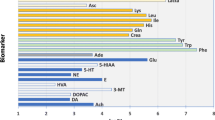Abstract
Objective
To clarify the seasonal differences of the trace element excretion in sweat, the trace element concentration in sweat and their loss during exercise were compared between summer and winter.
Methods
Sweat samples were collected from ten healthy adult males. Bicycle ergometer exercise was conducted by each subject at a heart rate of 140 beats/min for 1 hour, in summer and in winter. Sweat was collected by the arm bag method.
Results
Concentrations of major (Na, K, Ca, and Mg) and trace elements (Zn, Cu, Fe, Ni, Mn, and Cr) in sweat tended to be lower in summer than in winter, and significantly lower concentrations of Mg (p<0.01), Na, Cu, and Mn (p<0.05) were found in summer. The sweat volume in summer (0.90 L) was 1.7-fold larger than that in winter (0.52 L) (p<0.01). The amount of loss of each element to sweat calculated from the concentrations in sweat and sweat volume showed no significant difference between summer and winter.
Conclusions
It is suggested that there was no significant difference in the amount of loss of trace elements in sweat due to exercise between summer and winter.
Similar content being viewed by others
References
Clakson PM, Haymes EM. Trace mineral requirements for athletes. Int. J. Sport Nutr. 1994; 4: 104–119.
Hunt SM, Groff JL. Advanced Nutrition and Human Metabolism. MN: West St. Paul, 1990: 286–318.
Campbell WW, Anderson RA. Effects of aerobic exercise and training on the trace metals chromium, zinc and copper. Sports Med. 1987; 4: 9–18.
Dressendorfer RH, Sockolov R. Hypozincemia in athletes. Phys. Sports Med. 1980; 8: 97–100.
Haralambie G. Serum zinc in athletes in training. Int. J. Sports Med. 1981; 2: 136–138.
Singh A, Deuster PA, Moser PB. Zinc and copper status in women by physical activity and menstrual status. J. Sports Med. Phys. Fitness 1990; 30: 29–30.
Cook ID. The effect of endurance training on iron metabolism. Seminars in Hematology 1994; 31: 146–154.
Pate RR, Maguire M, Van WYKJ. Dietary iron supplementation in women athletes. Phys. Sports Med. 1978; 17: 81–86.
Nishiyama S, Imoto T, Nakamura T, Higashi A, Matsuda I. Zinc status relates to hematological deficits in women endurance runners. J. Am. Coll. Nutr. 1996; 15: 359–363.
Hoshi A, Watanabe H, Kobayashi M, Chiba M, Inaba Y, Kimura N, Ito T. Concentrations of trace element in sweat during sauna bathing. Tohoku J. Exp. Med. 2001; 195: 163–169.
Ohara K. Advances in Climatic Physiology, Tokyo: Igagu Shoin, 1972: 122–133 (in Japanese)
Watanabe A. Sampling of the human body component. Excretory liquid. Kodansha, Tokyo, 1972; pp. 113–133. (in Japanese)
Shinohara A, Chiba M, Inaba Y. Analysis of trace elements in biological materials by microwave induced plasma-mass spectrometry. Jpn. J. Hyg. 1994; 49: 924–934. (in Japanese)
Rowell LB. Human cardiovascular adjustments to exercise and thermal stress. Physiol. Rev. 1974; 54: 75–159.
Nielsen B, Nielsen M. On the regulation of sweat secretion in exercise. Acta Physiol. Scand. 1965; 64: 314–322.
Ogawa T. Exercise and sweating. Jpn. J. Sports Sci. 1983; 2: 432–443. (in Japanese)
Nishimuta M, Kodama N, Ono K, Kobayashi S, Suzuki K. Mineral contents in arm sweat at a low mineral diet with special reference to the onset of physical exercise. Magnesium 1985; 4: (in Japanese)
Aruma OI, Reilly T, MacLearen D, Halliwell B. Iron, copper and zinc concentrations in human sweat and plasma; the effect of exercise. Clin. Chem. Acta 1988; 177: 81–88.
Tipton K, Green NR, Haymes EM, Waller M. Zinc loss sweat of athletes exercising in hot and neutral temperatures. Int. J. Sport Nutri. 1993; 3: 261–271.
Waller M, Haymes EM. The effects of heat and exercise on sweat iron loss. Med. Sci. Sports Exerc. 1996; 28: 197–203.
Ogawa T, Asayama M, Miyagawa T. Effects of sweat gland training by repeated local heating. Jpn. J. Physiol. 1982; 32: 971–981.
Author information
Authors and Affiliations
Corresponding author
Rights and permissions
About this article
Cite this article
Hoshi, A., Watanabe, H., Chiba, M. et al. Seasonal variation of trace element loss to sweat during exercise in males. Environ Health Prev Med 7, 60–63 (2002). https://doi.org/10.1007/BF02897331
Received:
Accepted:
Issue Date:
DOI: https://doi.org/10.1007/BF02897331




